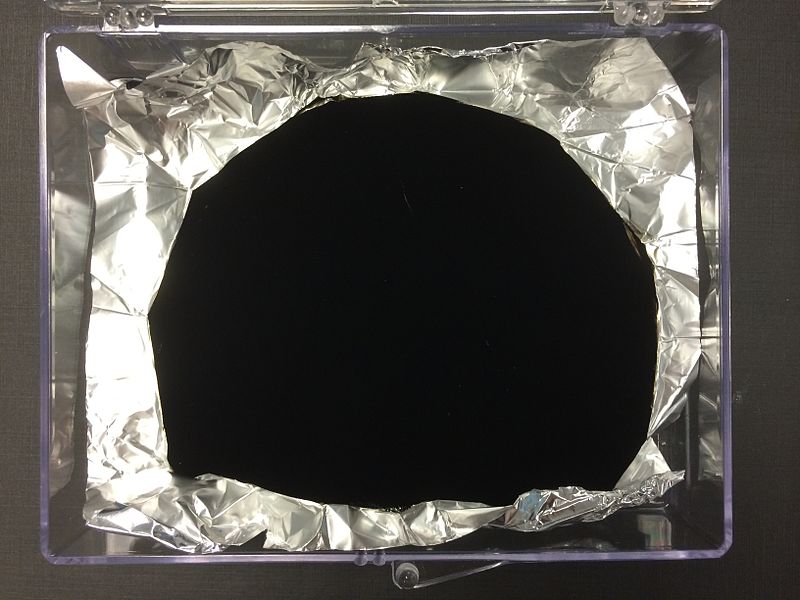The Creation of the World’s Blackest Material Is Inspired by an All-White Beetle

Nanoparticle Rods and Spheres, Image credit: (c) 2015 Nature Nanotechnology (2015) doi:10.1038/nnano.2015.228
Black, technically, is not a color but the absence of colors. It is the complete opposite of white or the presence of all colors. Something appears black because it does not reflect light or absorbs most of the light that hits its surface. Conversely, something appears white because it reflects all of the colors that hits its surface. The world’s blackest material, hence, is something that does not reflect any color or allows only a very minimal amount of light to bounce back. This may not sound interesting to most people but for scientists, creating the blackest material is something worth pursuing.
Recently, a group of researchers at Saudi Arabia’s King Abdulla University of Science and Technology reportedly developed a material that is even blacker than the Vantablack developed by Surrey NanoSystems earlier this year. The paper detailing the development of this new material has been published in the journal Nature Nanotechnology.
Beetle Inspired Material
Interestingly, the development of this new material has been inspired by a beetle, the cyphochilus beetle in particular. No, this beetle is not black though. On the contrary, it is an all-white beetle that displayed an amazing ability to show a very white color. The researchers observed the photonic crystal structure of the scales that coat the body of the cyphochilus beetle. Upon realizing how this crystal structure enables the extremely efficient reflection of all light colors, they thought they can create the exact opposite of such a structure to achieve the opposite effect — extreme blackness.
Blacker than Blackest
This new blackest material created by researchers at King Abdulla University of Science and Technology (KAUST) bests all other materials previously reported as the blackest. It is able to absorb approximately 98% to 99% of the light hitting its surface. These numbers are not as high as the record set by the Vantablack, which claims light absorption at 99.965%. However, reports share the consensus that it is already the holder of the record for being the blackest material created by man. Perhaps, this claim is justified by this new material’s ability to absorb, on average, 26% more incident light compared to carbon nanotubes. Also, the 98% to 99% light absorption rate of this new material covers the light spectrum between 400 and 1,400nm, which basically includes infrared light. Moreover, the light absorption of this material remains high across angles.
To put things in perspective, black paint has the ability to absorb around 90% to 95% of light and the military material Z306 or Aeroglaze can absorb up to 96% of light. No material with a full 100% light absorption exists yet. Black holes have the ability to suck in all light but they are not a material. Basically, looking into this extremely black material is like looking into a hole. It creates the illusion of nothingness that the brain is tricked into thinking that if you poke your finger into the material, it would get through as if you are poking into a hole. Also, this material has the tendency to distort the human ability to discern the shape and form of the material. Because of its extreme ability to absorb light, it would blur borders and blend into its environment.
A Product of Nanotechnology
This new material was created by putting an extremely minute nanoparticle rod on an equally tiny nanoparticle sphere around 30 nanometers in diameter. Together with the idea of chaotic energy harvesting, the researchers were able to produce something extremely black with a surface that has a pattern of random pits consisting of extensively long metallic waveguides. Out of curiosity, this material was also tested with a laser. The researchers found that when a laser beam hits it, a new type of light source was created, one that generates monochromatic emissions or single-color energy pulses without resonance. Moreover, the process of creating this new material is relatively easy. It can also be used in a liquid environment.
Applications
So why exactly do scientists want to produce a material that is blacker than what is already currently the blackest? If you think the reason is whimsical, think again. A material with the ability to absorb almost all of the light that hits it is highly useful in the field of solar panel production as it enables the efficient harvesting of light, as well as in concentrated solar power technology and desalination systems. Additionally, it can be used for military purposes, to create suits for night operations or camouflaging. Also, this new material is excellent for improving the performance of infrared cameras in space and on earth, as it prevents stray light from entering the telescope.
Commercial Availability
There haven’t been details yet on plans to make this material commercially available. IN an interview with Chemistry World, Andrea Fratalocchi of KAUST said that they are already in the process of optimizing a prototype. Hopefully, it can be mass produced soon. This remarkable material does not only have applications in optics, solar power generation, and the military, it may even be used in fashion and everyday items.
